 W
WAgop Batu Tulug Caves is an archaeological site in the Malaysian state of Sabah and refers to a group of several caves in a steep limestone cliffs in the Kinabatangan district.
 W
WThe Atkinson Clock Tower is the oldest standing structure in Kota Kinabalu. It was originally known as the Atkinson Memorial Clock Tower and sits in solitary on the bluff along Signal Hill Road overlooking this seaside city and capital of Sabah, Malaysia.
 W
WThe Cenotaph, also known as Penang War Memorial, is a cenotaph located at the Esplanade in George Town, Penang, Malaysia. The site of the Cenopath is situated at the shoreline of the Esplanade, at Jalan Tun Syed Sheh Barakbah and Jalan Padang Kota Lama, by the padang and the City Hall that it fronts.
 W
WThe Chartered Company Monument is a monument in the town of Sandakan in Sabah, Malaysia dedicated to the British servicemen or employees who were killed at the end of the 19th century. The monument was built by the British North Borneo Company and part of the Sandakan Heritage Trails, a trail which connects the historic sights of Sandakan.
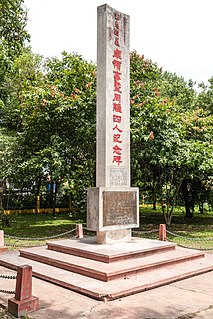 W
WCho Huan Lai Memorial or also known as Keningau War Memorial in the Malaysian town of Keningau in Sabah is a monument dedicated to Chinese Consul General Cho Huan Lai and his colleagues who died on 6 July 1945 after being executed by the Japanese.
 W
WThe De Fontaine Memorial is a monument built by the North Borneo Chartered Company to remember an incident on 12 May 1885 that led to an ambush attack to the North Borneo Armed Constabulary, in which five members of the police force were killed. The monument stands in the village of Kawang in the Malaysian state of Sabah.
 W
WThe Double Six Monument is a memorial located at Sembulan area in Grace Garden housing complex in Kota Kinabalu, Sabah, Malaysia which marks the site of 6 June 1976 fatal plane crash known as the Double Six Tragedy bearing the first Chief Minister of Sabah, Tun Fuad Stephens, as well as six other State ministers.
 W
WFort Margherita is an old fort constructed in 1879 by Charles Brooke, Rajah of Sarawak situated in Kuching, Sarawak, Malaysia. The fort is an important landmark and monument in Sarawak's history which goes back to the Brooke Dynasty. The fort, built in the style of an English castle, was designed to protect Kuching from being attacked by pirates. It served as a Police Museum from 1971 before being handed over to the Government of Sarawak and now is a tourist attraction in Kuching. The fort now houses the Brooke Gallery, an exhibition showcasing the history of Sarawak under the Brooke Dynasty.
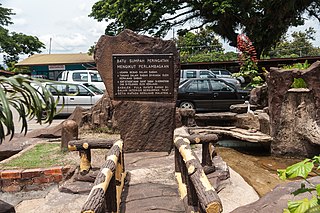 W
WThe Keningau Oath Stone is a monument in Keningau, Sabah erected to commemorate the terms in which the former British Crown Colony of North Borneo joined the former colony of Sarawak and the other states of the Federation of Malaya to form Malaysia.
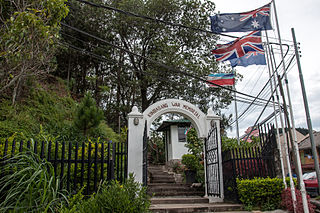 W
WThe Kundasang War Memorial is a memorial located in Kundasang in the Malaysian state of Sabah, which is dedicated to the British and Australian soldiers who died in the Sandakan POW camp during their death marches to Ranau. Besides that, it also recognises the suffering and sacrifice of the native population of Sabah.
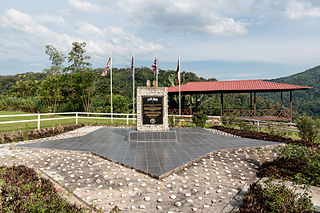 W
WThe Last POW Camp Memorial is a memorial in the district of Ranau in the Malaysian state of Sabah, which commemorates the victims of the Sandakan Death Marches who died during their march to Ranau. Of 1,047 British and Australian prisoners of war, only 189 survived to reach this site which is located near Liwagu Valley. Of these 189 total, 153 prisoners died in the next six weeks, 32 were murdered, while only four managed to escape. The current memorial was built where the former camp was located.
 W
WThe Leaning Tower of Teluk Intan is a clock tower in Teluk Intan, Hilir Perak District, Perak, Malaysia. It is the Malaysian equivalent of the world-famous Leaning Tower of Pisa in Italy. The tower is slanted leftward, similar to the Tower of Pisa. It is 25.5 metres tall and, from the outside, looks like an 8 storey building, though inside it is actually divided into 3 storeys.
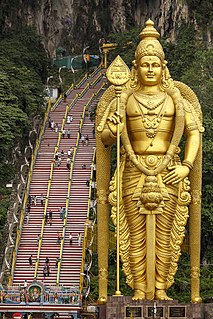 W
WLord Murugan Statue, representing Kartikeya, is the tallest statue of a Hindu deity in Malaysia and third tallest statue of a Hindu deity in the world, after Garuda Wisnu Kencana Statue in Indonesia and Kailashnath Mahadev Statue in Nepal. It is also the tallest statue in Malaysia at 42.7 metres (140 ft) in height. It is located at the Sri Murugan Perumal Kovil at the foot of Batu Caves. It took 3 years of construction and unveiled in January 2006 during Thaipusam festival.
 W
WThe Melaka Warrior Monument is a monument in Melaka City, Melaka, Malaysia. The monument was built to commemorate the Chinese victims of the Empire of Japan occupation of Melaka during World War II.
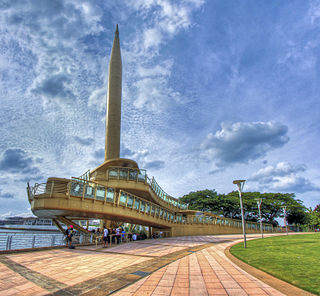 W
WMillennium Monument is a national monument in Putrajaya, Malaysia which is analogous to the Washington Monument in Washington DC, United States. It was the second national monument to be built in Putrajaya after Putrajaya Landmark. It is shaped like an obelisk with etchings denoting important periods and milestones in the nation's history. The monument is 68m tall. It stands in a 25-hectare park in Precinct 2. The monument is constructed of solid metal structures. At night, the monument serves as a beacon with strong light projected at 360 degrees and sweeping lights visible from various locations in Putrajaya. The lights also guide the cruise boats.
 W
WThe National Heroes Square is a monument and war memorial in Putrajaya, Malaysia. The memorial is located at Precinct 1 to replace the National Monument as a venue of Warriors Day. The Heroes Square is laid down in a similar pattern to that of Horse Guards Parade.
 W
WThe National Monument is a sculpture that commemorates those who died in Malaysia's struggle for freedom, principally against the Japanese occupation during World War II and the Malayan Emergency, which lasted from 1948 until 1960. It is located in the Federal capital, Kuala Lumpur. The Malaysian Houses of Parliament is situated near the monument.
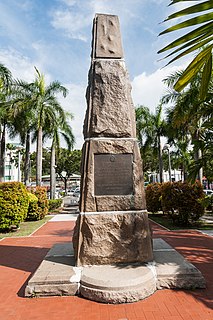 W
WThe North Borneo War Monument is a monument that was erected on 8 May 1923 by the North Borneo Chartered Company in Bond Street, Jesselton, British North Borneo. Originally, it was a memorial for the fallen British soldiers during the World War I but later extended to include the Australian soldiers in World War II. The monument stands today in the city park of Kota Kinabalu, the capital of the Malaysian state of Sabah.
 W
WThe Petagas War Memorial or Petagas War Memorial Garden is a memorial park dedicated to the Second World War victims in Sabah particularly to 324 resistance movement members, who were executed on 21 January 1944 at the site by the Japanese occupying forces of North Borneo for their involvement in the Jesselton Revolt. The park memorial plate lists the names of men of various ethnic groups in North Borneo and from various islands in the Sulu Archipelago including the main resistance leader Albert Kwok and those who assisted or died in Labuan Military Prison. The park was built exactly on the site where the massacre took place and where the victims were initially buried. It is located in Kg. Peringatan Petagas in the district of Putatan in Sabah, Malaysia.
 W
WQuailey's Hill Memorial is a memorial located in the district of Ranau in the Malaysian state of Sabah. It commemorates an Australian POWs, Allan Quailey who been killed on 16 February 1945 during the first Sandakan Death Marches by the Japanese soldiers.
 W
WSandakan Heritage Trail is a trail connecting several historical sites in Sandakan, a town in the east Malaysian state of Sabah. It is marked with white concrete tiles placed on the ground showing a red footprint the words "Heritage Trail" in either black or gold.
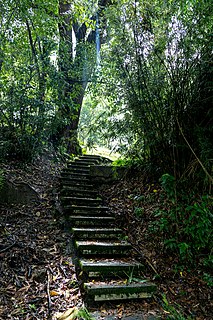 W
WSandakan Japanese Cemetery is an old graveyard in Sandakan, Sabah, Malaysia. Located on a hill about 2 kilometres from the town central business district, it is a cemetery where the remains of many Japanese female prostitutes called Karayuki-san from poverty-stricken agricultural prefectures in Japan who were sold into slavery at a very young age years before the World War II which also include recent comfort women during the war. It is part of the Sandakan Heritage Trail.
 W
WSandakan Massacre Memorial consists of three monuments which commemorate 30 Chinese victims, most of the members are local elite of an underground movement who been executed on 27 May 1945 along with several other victims during the Japanese occupation of North Borneo. The memorial was built on the spot where the massacre took place and where the victims were buried. It is located near a Chinese cemetery on a hill above the old town centre of Sandakan.
 W
WThe Sandakan Memorial Park is a memorial site built in the former grounds of the former Sandakan camp in the Malaysian state of Sabah. The site is dedicated as a memory for all prisoners in the camp who died during the Sandakan Death Marches, and to those died during a march to Ranau. It is also recognises the suffering and sacrifice of the native population.
 W
WThe Sandakan War Monument is a monument established by the British located in the town of Sandakan to commemorates the town citizens who lost their lives during the Second World War. The monument is part of the Sandakan Heritage Trails, a "Heritage Trail" which connects every historic sights of Sandakan.
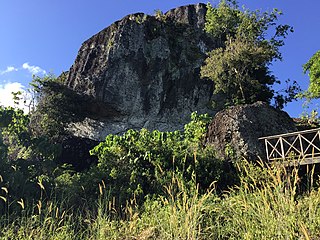 W
WSkull Hill is an archaeological site hill located at Tampi Tampi Road, about 10 kilometres (6.2 mi) south of Semporna town.
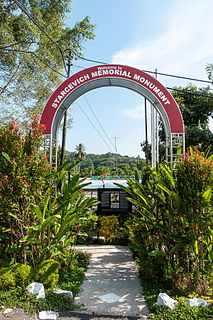 W
WThe Starcevich Monument or Beaufort Australian Monument is a monument in the town of Beaufort in Sabah, Malaysia dedicated to Tom Starcevich from the 9th Division Army of Australia during the reconquest of the town by the Allied forces on 28 June 1945.
 W
WThe Tawau Bell Tower is the oldest standing structure in Tawau, constructed by the Japanese to commemorate the signing of armistice agreement following World War I when Japan was an ally of Great Britain.
 W
WTawau Japanese War Memorial is a former Japanese cemetery in Tawau in the Malaysian state of Sabah which now has been transformed into a memorial.
 W
WTorana Gate is a torana in Brickfields, Kuala Lumpur. The gate is a gift from the Government of India to Malaysia, as a mark of continued friendship between the two countries. It was influenced by Hindu and Buddhist architecture of the Indian subcontinent.
 W
WTugu Keris is a huge monument in the shape of a kris in Klang, Selangor, Malaysia. Its construction was ordered by the Sultan of Selangor, Almarhum Sultan Salahuddin Abdul Aziz Shah to commemorate the Silver Jubilee of his reign on 30 September 1985.
 W
WWilliam Pryer Monument is a monument that stand in the Malaysian town of Sandakan as a memory of the founder, William Burgess Pryer. It is part of the Sandakan Heritage Trails, a trail which connects all the historic sights in Sandakan.